The MGB was something of the “big brother” to the MG Midget and was in production throughout the 1960s/70s. It was built by the British Motor Corp. which would later be a part of British Leyland. It was quite popular and comprised most of the more than 500,000 copies made of the MGB and its variants. The seller jokingly says this car is a barn find – because he “found” it in his own barn! It looks to have been there quite some time, no longer runs and was in an accident at some point. Located in Quakertown, Pennsylvania (near Allentown), it’s available here on craigslist for the cheap wheels price of $750. Thanks, Barn Finds reader Mitchell G, for turning us on to this one!
The MGB replaced the MGA in 1962 and production continued through 1980. The Roadster, like the seller’s car, was the first MGB body style built. It was purely a two-seater, although a tiny rear seat became a seldom-ordered option. The MGB had more passenger and luggage space than its predecessor and it came with a 1.8-liter L B-Series inline four-cylinder engine with four-speed manual transmission. The 1973 models sold in the U.S. were the last before bigger and bulkier front bumpers came along due to Federal safety requirements. They changed the look of the car substantially, and not for the better according to some.
We don’t get any of the history of the owner’s car other than it’s apparently been a dweller in his barn for a long time. All the dust and dirt on it is original, not aftermarket. The body appears good except for the right front fender, headlight bezel and hood which no doubt collided with something. The seller has a replacement fender that he will toss in with the deal. We’re told there is rust underneath the car, but we have no images of it. These cars were known to be rust magnets.
The interior is mostly okay with tears in the seats to deal with and the carpet is likely shot. What worries me is the collection of exposed wires under the dash and steering wheel. That in itself could be a warning sign that more trouble awaits. And, finally, both the engine and transmission don’t budge. This car might prove better as a parts car for another project rather than as an expensive restoration. Either way, it’s hard to argue with the price.






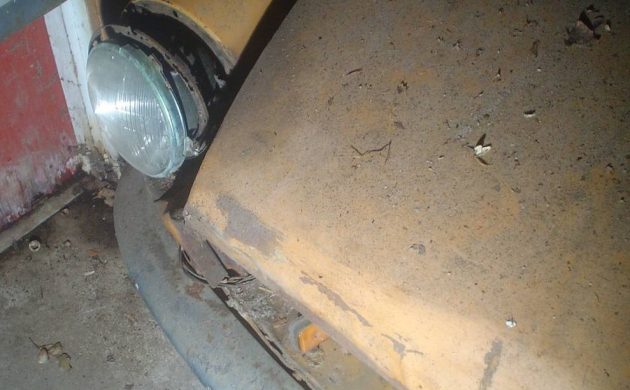

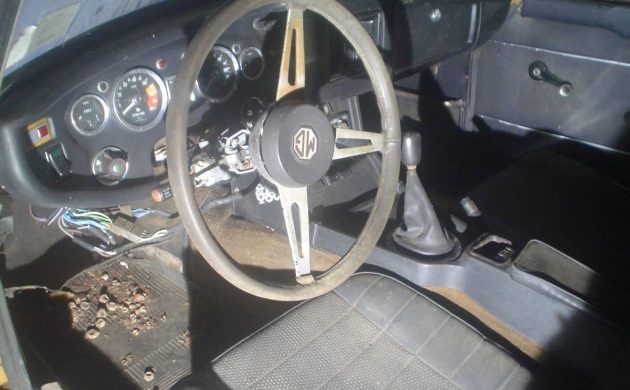
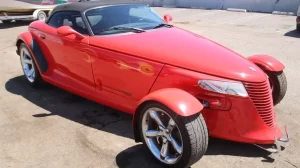
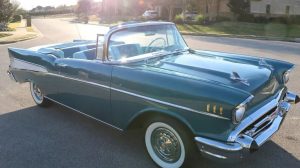
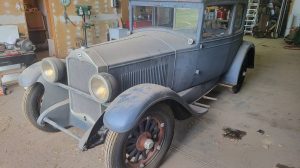
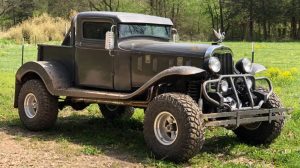


Here’s a knife in the gut, properly turned, gives me the feeling I have now. My ’71 was this color originally. Put a quarter million miles on that car,( before it broke in half) so don’t anyone say they are inferior. In all those miles, that car only stranded me once. It was in a blinding snowstorm, when the motor quit, I opened the hood, and it was PACKED with snow. Dried the cap and wires and I was on my way. Oh sure, a tail light blinked on and off or a signal stopped working, but that was because the fusebox was under the hood, ripe for corrosion. I don’t recall that cars electrics any better or worse than any other car. This car is a treasure trove of parts, but I wouldn’t waste a nickel on trying to restore it. I never liked what they did to the dash on these anyway. I get a kick out of the hood dings. Before the rubber bumpers, anyone with a small sports car learned, not to park too close to the car in front of you.
My cousin had a ‘69 MG Midget. It spent more time in the shop than on the road. I always thought it would be kewl to own one, but, “Super Sport 396” took my attention. IMHO, an MG in a disrepair condition is NOT a good investment.
Buy one RUNNING, otherwise it’s nothing but a “Money Sink.”
Harvest Gold, just like my current 74 Midget. Alternately called butterscotch, mustard, or my favorite, “Poupon.” So veddy British and also very much a color only the 1970s could create.
Actually, the Midget was a cousin (and rebadged off-shoot) of the Austin-Healy Sprite, which came first. The first Sprite was rebodied and shared mechanicals and body design with the rebadged Midget. The Midget was designed to carry over hints of the then-new and wildly popular MGB, like the tail light and rear quarter treatments. I had a ’68 Midget which went on and on for years, matching my ’68 Volvo 122S Wagon in reliability, not to mention ease of maintenance. (I got both cars used.) The biggest problem with the Midget was sorting out all the mechanical and electrical “improvements” that he made it, which were more trouble than they were worth. Once I got it back to near original spec, all was well. Both cars shared some features, like twin SU’s and similar electrics. The Volvo was, certainly, more robust (and actually faster) than the Midget, but with normal maintenance that those generation of vehicles required both went on and on and on. Both had their rust issues, too, especially with all the nooks and crannies in their approach to body-on-frame construction. I think that the biggest downfall with the Midget was the quality of the enamel paint. After a repaint with modern paint and undercoating, plus regular routine care, those problems when away. I like the trouble free reliability of my Hondas, but I do miss driving my Midget!
The advice above, though, is correct. Unless you really *want* to do the restoration work (and God bless you, if you do!) get a sound, running, example. Hopefully, someone will give this car the attention it deserves and get it back on the road.
The square-body Spridget (launched May 1961) actually preceded the MGB (Sep 1962).
I think Andrew was adding background to the comment that the B was the big brother to the Midget. His words sidestepped the chronology of each car’s launch to the public. Perhaps his statement should read “The MGB carried over hints of the then-new and wildly popular Midget/Sprite, like the tail light and rear quarter treatments.” I would add, the Midget wore the full length beltline trim similar to the B and was configured the same way with an exposed fuel filler, upright polished metal windshield frame and vent windows, and large toothy grille.
As long as the floors can support the floormats they’re in good shape. This car looks better than the first MGB I had and it lasted through a Michigan winter. Pour a little Marvel Mystery oil through the spark plug holes, wait a week, and start driving this sucker.
One photo shows a 1987 inspection/registration sticker on the windshield.
If it’s been sitting in one place for 30+ years, that would explain the collection of nuts etc. around the engine compartment and on the floor.
If this has been a squirrel hideout and mouse motel for that amount of time, you can be assured of chewed wires and rust throughs wherever nests were built.
Rodent urine is as bad as battery acid IMO.
Don’t ask how I know !
Not mentioned above is the fact that over a half-million MGBs were built over an 18-year production period – they’ve always been wildly popular. They remain a very popular collector-car with terrific club and aftermarket support. Parts are readily available at modest prices – including body panels made on original tooling, sold by the British Motor Heritage Trust. These panels really fit! The only time I’ve known them not to fit was when the car itself was bent. Common rust repairs needed on examples like this one are floors, complete sill sections (they’re structural) and “dog-legs” and rear wheel-arch areas. You needn’t buy whole new rear quarter panels, as smaller repair sections are also available.
The trunk (boot, please) floors on these cars rarely rust out, although the tops of the gas tanks bolted on directly below frequently do. Even in severely rusted examples, these cars, being way over-built as they were, can maintain body integrity (if not safety!) right up to the bitter end. Generally that’s due to the “spine” which would be the transmission tunnel – protected by a design feature for which MG engineers were rarely given adequate credit. Oil seals on engine and transmission were designed so as to leave an oil deposit on the bulkhead (fire wall) and tranny tunnel so as to prevent rust in these structurally critical areas.
These pictures don’t really show the gap where the rear of the door meets the B-pillar. But if that gap gets wider toward the bottom, that means the car is sagging. If it is a particularly significant car, it can be saved, but generally that is where I draw the line. Generally, I think this car is much better than that.
Color is a bit difficult to determine from these photos, but I believe this one is “Bronze Yellow” rather than “Harvest Gold”. I have had both colors. The latter does not age well, and the weathered example I had was often referred to as “baby diaper brown”.
The exposed wiring below the steering column is NOT a matter of concern. I see that the left-side half of the steering-column cowl has been removed. I would surmise that somebody needed to replace the turn signal switch at some time, and that involved pulling the wiring harness down to get at the plug for the switch sub-harness. There is supposed to be a dash bottom cover – missing on most MGBs by now. That leaves these wires hanging just as these are – on perhaps half the MGBs on the road today. And that brings me to another point: the MGB is about the only vintage British sports car that is still suitable for modern traffic. A huge benefit in this regard is the optional overdrive. Without visual inspection of the bottom of the car, it’s impossible to tell if the car has overdrive. If it does, the overdrive transmission itself is worth the seller’s $750 price.
My major concern about this car would be the seized engine. But barring a freak incidence of great luck, one would assume that the engine would need rebuilding anyway. Pressing out seized pistons; even pressing in new cylinder liners would not add that substantially to the cost. In the MGB community, we do not worship at the throne of the numbers-matching car, so a replacement engine is not a big deal.
I already have four of these, so I’m not in the market. If I were shopping for a project, I’d be a real fool if I didn’t give this one a hard look. This could be a real steal!
Forgot “baby diaper” as another name for the paint. I should know, I’ve got a 1.5 year old at home. And that 74 Midget in my profile. If this is Bronze Yellow, it would be an exact match to another salvaged MGB I extracted somewhere up in Kentucky in 2016. It had overdrive, so me and a buddy pounced on it for only a few hundred bucks. The rest of the car had rusted around the driveline as you said. And, as you said, we sold the OD gearbox for $850 no questions asked at the next Brit club annual show. The seller was able to lean under the car and snap a few pics of the overdrive box before we trucked several hours to inspect the car.
Cars from this era required weekly inspection and monthly tuning. All simple and fun jobs. If you are the kind of person who farms this work out these are not the cars for you. But if you like to pretend to be a mechanic and play a bit under the hood.(bonnet) these cars are an absolute joy.
Weekly inspection might be a good idea, although just a check of fluid levels is sufficient. As for “monthly tuning”; Kelley, I’m sorry but THAT is simply untrue. My ’73 MGB/GT has been my daily driver for most of the last 34 years. It has a quarter of a million miles on it. In my line of work before retirement, “on time” was late – you always had to be there at least 20 minutes ahead. I always drove my B/GT – except when there was snow and salt on the roads, and I was never late.
I use Pertronics ignition with MSD – allowing .050 gaps on my plugs, and a rebuilt distributor from Jeff Schlemmer. I can’t remember the last time I even looked at a spark plug. I check my SU carbs every four-five years – and usually they require no attention. So much for MONTHLY TUNING, indeed!
Yes these cars require more attention than modern cars, and they require a driver with a “mechanic’s ear”.
I do not pretend to be an expert. When I do tune SU carburetors, I set ’em so they run “pretty good”. That is, realistically, as good as they get. Step two of the process is to LEAVE THEM ALONE! The guys who fuss with their carbs all the time are the guys who end up hating their MGBs cuz they just don’t get it. These MGs are not Ferraris. If you have real problems tuning your SU carbs and can’t find the “sweet spots”, it’s because those carbs need rebuilding. Do it! Just once! You’re now set for the next 100,000 miles – at least.
Yes: change your engine oil – at least twice a year. And grease everything that has a zirk fitting, check transmission and rear end oil levels, top up the hydraulic fluids, oil the centrifugal advance, and check the dashpot levels. Every couple years you re-torque head studs and adjust valves. Every two or three years you flush the brake- and clutch-fluids. Modern cars have computers. So do MGBs – the computer sits in the driver’s seat. That’s you, and you and the car are in a partnership. Together, you do great!
Best and most positive post of the year! Thank you!
@Allen. Well said!
curvet and Little_Cars,
Thanks for your encouragement, guys. I was rather hard on poor Kelly, for which I need to apologize. He’s probably a better wrench than he admits and he speaks of “absolute joy” coming from tinkering under the bonnet. Kudos, Kelly, how can that possibly be wrong! Go ahead and tune – monthly, weekly, daily for that matter. The car might not need it – but maybe you do! We all have our unique ways of loving these wonderful old cars. Who am I to deprive you of yours?
I believe in being responsible for your own transport. In fact, I’ve always maintained that one should never rely on a machine one does not understand. Well… Computers changed all that; I’m now a victim of a machine about which I know absolutely nothing. If something goes wrong, all I can do is reboot it. Turn it off and then on again. Our old British cars have a unique feature in that regard: when something goes wrong, they shut themselves off, saving you the trouble. All you have to do is turn them back on again.
In this regard the auto industry lost me sometime shortly after 1980. I look under the bonnet. If I see a distributor and a carburetor, I have a fighting chance. Once those were gone, and then they began covering the whole engine with a plastic shroud, all I can do is call AAA. Let me be embarrassingly frank: we’ve had our 2014 Chrysler Town & Country for six years and I’ve never had the bonnet open! There’s no point in it. There’s nothing in there that I understand. Nor is there anything I need to understand. The damn thing is infallible. So much for the romance of motoring. The partnership of which I spoke is gone – I’ve been voted off the island. Yup, my EFI, TDC sensor, and my throttle position sensor got together and held a vote. They don’t need me anymore. Pretty soon they won’t even need me to drive. Pretty soon, we won’t need people anymore.
Case in point: my computer knows that I couldn’t have meant “CCRVTT” so it substituted it’s own judgement . Of course, said my software, I must have meant “CURVET”. I believe those are made by Chevrolet, right? At any rate, I was not a part of the decision. I became superfluous…
Little-Cars…Spridgets didn’t get the vent/roll up windows until the late’64 models when they introduced the 1098 engine. Never appreciated the possibilities of roll up windows until I left my ’62 Midget out in a snow storm one night and woke up to a car full of snow. Our ’64 Sprite race car pictured.